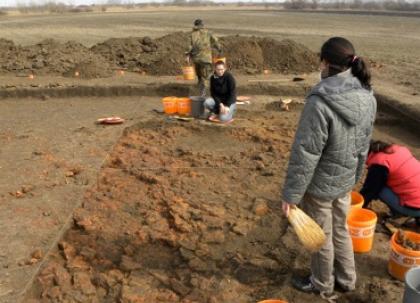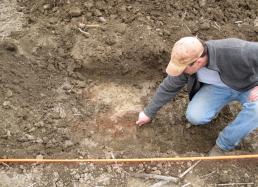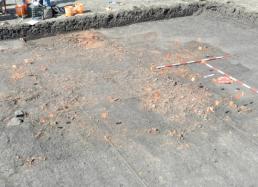1. "Egyböl belevágtunk a közepébe!" (We hit the ground running!)
The literal translation of my blog title means “We cut the whole thing right in half!” It's a Hungarian colloquialism that means “We nailed it!” or “We hit the ground running!," which is certainly true of our start during this year's expedition season. To give you the play-by-play, Rick Yerkes (Ohio State University) and I arrived Sunday afternoon. Attila Gyucha (Hungarian National Museum) met us at the airport with Paul Duffy (University of Toronto), who arrived a couple weeks ago to work on his own project, which focuses on the Bronze Age. Two graduate students from the University of Illinois at Chicago, Danielle Riebe and Rebecca Seifried, had caught flights earlier in the week. We picked up the 4x4s and drove to Békéscsaba, the Körös County seat, to spend the night.
By 9 AM Monday morning, Dani and I were on the site re-establishing the topographic grid from last year and laying out topographic points so we could begin work on Tuesday morning. Everyone else loaded up the equipment and moved into the dig house in Vésztő. Monday night, most of the other team members arrived from Hungary, Lithuania, and Belgium. At breakfast on Tuesday morning we had 25 people, and by the end of the week more Hungarians arrived, bringing our team number to 30. When the Greek geophysical team arrives at the end of the month, we'll have representation from six countries and number about 35 people.
The first order of business was to initiate excavation over the two longhouses that we'd discovered during previous seasons through surface survey and geophysical prospection—one in the north field (Block N1B1) and one in the southeastern field (Block SE1B1). As we removed the plowzone, it immediately became apparent that all of our efforts had paid off. Both places contained clear scatters of daub (burnt wall rubble), which indicated that there once had been wattle-and-daub structures at these locations.
For example, in Block N1B1 we found a massive concentration of daub at the base of the plowzone, exactly where it was indicated in both the magnetometric and ground penetrating radar surveys (see above photo.) Based on the ceramics that we found above the rubble, we’re confident that this longhouse is Neolithic in date (see Photo #1 below.) And in Block SE1B1, we also found a concentration of daub underneath the plowzone (see Photo #2 below.) Unlike the massive, thick, dense concentration in Block N1B1, the daub in Block SE1B1 consists of smaller pieces that are more unevenly distributed throughout the unit. That said, the concentration is located precisely where it “should be” based on the magnetometric survey last year. (We also did GPR in that area, but standing water present on the site last year made our efforts unsuccessful.)
So all in all, we’re thrilled that we've found what appear to be two different longhouses located in two different parts of the settlement complex. As excavations and studies continue, we’ll be able to compare them to each other to determine whether the structures date to different time periods, or whether they were used for different functions within the settlement. (Longhouses typically housed families or were used for rituals.) This is all critical for understanding how the settlement came about, and how it was organized when it was occupied.
In addition to excavations on the longhouses, Paul Duffy continued the surface collection at the site. We’ve now collected over 3,000 (10x10 m or 20x20 m) surface units so far! Within the next week, we’ll complete the surface collection and move the survey team (9 people) to different excavation areas. We also plan to find the old excavation trenches on the tell, which have proved annoyingly elusive so far.
We’re fortunate that we've had no rain yet this week. The fields all are dry, which lets us be much quicker and more efficient than when we have to deal with mud up to our knees. If the weather holds, we'll have a very successful season. Stay tuned!
—Bill





